#cloud computing technologies 2024
Explore tagged Tumblr posts
Text
2024 Most Influential Cloud Computing Technologies: A Detailed Recap
This year has been a thrilling journey through the landscape of technology. We were introduced to fascinating innovations that help businesses and individuals make life much easier. One such technology is Cloud computing; in the present market, the cloud has become a necessity rather than an option. It has revolutionized various industries in multiple aspects; with its robust technology and continuous evolution, it will also develop and surprise us in the coming years.
Cloud technology has transformed companies' digital transformation to attain sustainability, efficiency, and agility. As businesses increasingly turn to cloud computing, AWS cloud computing services are pivotal in driving these advancements. Cloud computing has continued to develop as a critical component of digital transformation with trends like increased Azure cloud sustainability calculator, edge computing growth, and AI integration.
Infosprint Technologies, an IT consulting company, invites you to embark with us on a thrilling adventure through cloud technologies in 2024. This blog will examine the newest developments and technologies that have shaped cloud computing this year, the key drivers behind these changes, and how they pave the way for the future.
The Cloud Gets Smarter: AI and ML Integrations
In 2024, artificial intelligence (AI) and machine learning (ML) are generating significant changes and opportunities. Integrating AI and ML through cloud services has opened up new business possibilities. Top cloud service providers, including Google, AWS, and Azure Cloud, have introduced advanced AI technologies that enable companies to automate complex processes, analyze vast datasets, and deliver personalized customer experiences.
AI-powered Infrastructure Innovations:
Artificial Intelligence has transformed cloud architecture by combining private and public infrastructure, allowing businesses to scale, manage, and secure their resources quickly. The platform-as-a-service also comes with built-in AI tools for seamless cloud deployment.
While AI cares for the infrastructure, developers can focus on building and deploying applications. Although integrating AI can complicate workload management, serverless computing enables users to run AI applications without the need to manage the underlying infrastructure.
AI-powered DevOps:
In 2024, DevOps revolutionized software development and deployment by streamlining and automating essential processes. Advanced CI/CD pipelines enhanced deployment efficiency, while tools like GitHub Copilot and AI-driven testing simplified development, error detection, and test execution.
Artificial Intelligence (AI) and Machine Learning (ML) improved resource allocation, predicted and mitigated system failures, and facilitated the creation of self-healing systems for continuous operation. Automated vulnerability discovery and solutions bolstered security and ongoing feedback loops prioritized updates. This integration not only increased productivity but also ensured that software was delivered in a secure, reliable, and cost-effective manner.
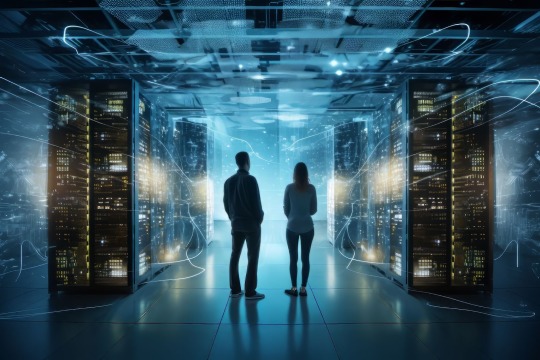
AI-powered industry-specific models:
In 2024, industry-specific AI models transformed key sectors by delivering tailored solutions to unique challenges. AI and machine learning (ML) improved diagnosis and personalized treatment plans in healthcare. These technologies were employed in finance to detect fraudulent activities and assess creditworthiness. Retail businesses enhanced consumer experiences through AI-driven recommendations and demand forecasting. The manufacturing sector benefited from advancements in quality control and predictive maintenance.
The potential of AI and ML to reshape industry operations was evident in their contributions to optimization, sustainability, and personalized services across various fields, including logistics, energy, education, and agriculture.
AI-powered cloud services:
These days, ML and AI are essential elements of cloud computing technologies. They optimize resource management and allow organizations to implement advanced analytical models. Cloud platforms that integrate AI provide 24/7 customer support while helping to reduce operational costs. With these cloud-based AI tools, businesses can forecast sales, manage inventory, and enhance their marketing strategies.
AI-powered cloud security:
In 2024, AI-driven cyber-attacks reached an unprecedented peak, making it challenging to identify their attack methods. As the saying goes, “Poison can be cured by poison,” similarly, AI threats can be addressed with AI-powered security solutions. AI cloud security equips companies with ever-evolving case studies and real-life scenarios to enhance their detection and response capabilities.
One such model is migrating from legacy to modern SIEM (Security Information and Event Management). Once companies transition to this model, they will benefit from substantial threat analysis and detection alerts, thanks to AI and advanced ML techniques.
Edge Computing: Rethinking the Rules of Connectivity
The growing need for real-time data processing propelled edge computing to unprecedented heights in 2024. Edge computing processes data nearer to its source, decreasing latency and enhancing the functionality of IoT devices, driverless cars, and smart cities.
Network connection:
5G networks represent a rapidly growing telecommunication technology that has redefined edge computing. With faster connections, reduced latency, and higher bandwidths, 5G enables real-time data collection and analysis, a business game changer. This advancement has facilitated using augmented reality, smart cities, and driverless cars, requiring quick responses. Additionally, 5G allows for deploying more edge nodes in urban and rural areas, bringing computational capacity closer to customers and devices.
Emerging use case:
In 2024, some of the highlighted edge usage was predictive machinery maintenance. The sensors at the edge collected and analyzed the machine data, making it possible to schedule regular checkups when necessary. Another highlighted case was in retail; they used edge to analyze in-store dynamics, enabling dynamic pricing, personalized promotions, and efficient inventory management. These applications proved the importance of edge computing and enhanced customer satisfaction.
Hybrid cloud:
Businesses adopted hybrid cloud infrastructure with edge computing nodes for their centralized benefits. These nodes made seamless data flow and processing across the environments. This configuration made it possible to use the cloud for advanced analytics, storage, and machine learning while facilitating real-time decision-making at the edge. Additionally, hybrid solutions improved flexibility by enabling companies to scale edge activities while keeping centralized control.
Flex Your Cloud Muscle: Mastering the Art of Multi-Cloud and Hybrid IT
In 2024, businesses adopted hybrid and multi-cloud methods to reduce workloads, boost resilience, and prevent vendor lock-in. Building interoperable solutions that incorporated the finest characteristics of several platforms took precedence over selecting a single supplier.

Unified management tools:
In 2024, the best cloud technologies in India, such as Google, AWS, Azure, and Arc, emerged as indispensable solutions for hybrid and multi-cloud platforms. These platforms allowed organizations to govern their workloads centrally, running across on-premises, edge, and multiple cloud platforms. By offering a single interface, they made tasks like deployment, resource allocation, and policy enforcement easier. Simplified management, less complexity, and consistent performance in various settings improved an organization's agility and efficiency.
Data portability and interoperability:
Businesses opted for data portability and interoperability to prevent vendor lock-in and ensure seamless business operations. Open system APIs enabled data to move across platforms without compatibility issues. This allows organizations to opt for the best services from different vendors while maintaining flexibility in switching. The focus on interoperability also supported innovation, as businesses could combine capabilities from multiple platforms to achieve their goals.
Enhance security protocols:
As multi-cloud and hybrid strategies were adopted, robust and reliable security measures were required. In 2024, improved security measures ensured private information was safe in various settings. Zero Trust Architecture, which verifies all access requests regardless of source, became the norm. These security advancements gave organizations the confidence to scale their hybrid operations without compromising data protection.
Sustainable Cloud: Green Computing for The Planet
Cloud providers made sustainability a high goal in 2024. Businesses were increasingly looking for sustainable cloud solutions that fit their ESG objectives. In response, cloud providers introduced tools to measure and lower carbon footprints and pledged to use renewable energy.
Achieve renewable energy milestone:
Cloud providers demonstrated their dedication to minimizing their environmental impact in 2024 by running entirely on renewable energy in strategic places. Businesses were able to monitor emissions and improve cloud usage for more environmentally friendly operations with the help of tools like the AWS Carbon Footprint Tool and Azure Sustainability Calculator.
Liquid cooling and AI-driven energy management are two innovations in energy-efficient data centers that have further increased efficiency and decreased power consumption. In addition to supporting firms' adoption of ecologically friendly practices, these initiatives complemented broader sustainability goals.

Quantum Cloud: The Sky's the Limit
Cloud companies like IBM, Microsoft, and Google led the way in 2024 as quantum computing became closer to being used in real-world scenarios. Thanks to these platforms, researchers and developers can now experiment with quantum algorithms, democratizing access to quantum computing resources.
Quantum-as-a-Service: Driving Industry Innovation with Hybrid Processing Models
In 2024, quantum computing made significant advancements, becoming more accessible and practical for businesses. Quantum-as-a-Service (QaaS) platforms, such as AWS Braket and IBM Quantum, introduced user-friendly interfaces that allowed non-specialists to experiment with quantum solutions without needing extensive expertise. Various industries, including pharmaceuticals, logistics, and finance, launched pilot projects to explore the potential of quantum computing. These projects focused on applications such as drug discovery, supply chain optimization, and financial risk analysis. The pilots demonstrated quantum computing's ability to address complex problems beyond classical systems' capabilities.
Additionally, hybrid processing models gained popularity, integrating quantum and classical computing to streamline workflows. Classical systems managed tasks like data preprocessing, while quantum computers tackled core computational challenges such as optimization and simulation. Overall, these developments indicated a shift toward practical quantum applications, positioning the technology as a transformative tool for innovation across various industries.
Enhanced Security: Zero Trust and Beyond
Security continued to be a primary concern for cloud computing in 2024 due to the emergence of sophisticated cyber threats. Cloud providers improved their services with cutting-edge security features to preserve compliance and safeguard sensitive data.
Zero trust architecture:
In 2024, Zero Trust Architecture (ZTA) emerged as a fundamental security framework that mandated businesses to verify all access requests through detailed access controls, whether from internal or external sources. Multi-factor authentication (MFA) and continuous monitoring were crucial for reducing the risk of internal breaches and improving perimeter security.
Confidential Computing
Enhanced data security during processing by using Trusted Execution Environments (TEEs) to safeguard sensitive information, even from the staff of cloud providers. This enabled secure computations in industries such as healthcare and finance.
AI-driven security
At the same time, AI-driven security solutions utilize machine learning to analyze security data in real-time, allowing for the identification and response to potential threats. This adaptive learning approach significantly reduces the impact of breaches.
These advancements significantly bolstered cloud security, ensuring data privacy and accelerating threat mitigation.
Connecting the Dots: IoT and Cloud Computing
Internet of Things (IoT) and cloud have redefined how data is stored, collected, and analyzed. The Internet of Things(IoT) collects vast amounts of data stored and analyzed in real-time. Meanwhile, cloud computing provides the scalability, flexibility, and processing power needed to handle this influx of data, enabling businesses to leverage IoT insights without the limitations of on-premises infrastructure.
Cloud-powered real-time data analytics enhances decision-making and streamlines operations by providing businesses with actionable information from connected devices. Companies can save money through pay-as-you-go models using cloud services instead of expensive on-premises infrastructure. Furthermore, cloud computing reduces operational complexity by allowing remote management and control of IoT devices, regardless of location. Advanced encryption and compliance measures implemented by cloud providers improve security and protect sensitive IoT data. As a crucial element of digital transformation, integrating IoT and cloud computing drives innovation across various sectors, including manufacturing, healthcare, logistics, and smart cities.
The future of cloud and beyond 2024
As 2024 approaches, cloud computing plays a significant role in digital transformation. This year's technological advancements and trends have not only altered how companies operate but have laid the groundwork for the future of the digital economy.The cloud has proven to be a flexible and essential platform for innovation, encompassing edge computing, AI integration, sustainability, and quantum technologies. By 2025, we expect these developments to mature and create even more opportunities.
#cloud computing technologies 2024#top cloud computing innovations 2024#cloud characteristics#cloud and cloud computing#top 10 cloud companies#best cloud service provider
0 notes
Text
Why AI-Powered Mapmaking is Essential to the New Era of Software-Defined Vehicles
New Post has been published on https://thedigitalinsider.com/why-ai-powered-mapmaking-is-essential-to-the-new-era-of-software-defined-vehicles/
Why AI-Powered Mapmaking is Essential to the New Era of Software-Defined Vehicles


The automotive industry is undergoing one of the most profound transformations in its history. Once defined by mechanical engineering and horsepower, today’s vehicles are increasingly shaped by code. We’re entering the era of software-defined vehicles (SDVs) where the intelligence of the car comes less from the engine block, but from lines of software. A recent study by Research and Markets projects that the global SDV market will grow from $213.5 billion in 2024 to over $1.2 trillion by 2030. That scale of growth is no surprise to those working at the intersection of software, mapping and AI. It’s a reflection of how rapidly the role of AI is expanding across every aspect of mobility.
AI will increasingly become the digital engine behind some of the most valuable vehicle functions: digital cockpits with natural language prompting, real-time navigation and dynamic routing, predictive maintenance, advanced driver-assistance systems (ADAS) and higher levels of automated driving. AI is helping to redefine and customize the driver experience. According to a recent IBM study, 74% of automotive executives believe that by 2035 vehicles will be both software-defined and AI-powered. And by then, 80% of new cars are expected to feature electric powertrains, providing an even more natural foundation for integrating vehicle systems, mapping, software and AI capabilities.
AI-Powered Mapping: The Digital Compass of SDVs
A particularly compelling example of AI’s role is in the evolution of digital mapmaking. A traditional static map is giving way to a “live” map: dynamic, constantly streamed representations of the road environment used to power an array of vehicle systems. A map is essential for safe and efficient driving in an increasingly electric, connected and automated vehicle.
A live map provides much more than simple navigation, enabling the vehicle to interpret its surroundings and make informed driving decisions in real-time. AI’s ability to detect patterns, recognize environmental changes, and update map data dynamically makes it possible for the driver (and vehicle systems) to avoid construction zones, reroute around traffic accidents and become aware of changes in road signage or speed limits.
We are already seeing live map capabilities that continuously integrate data from vehicle sensors, satellite imagery and crowdsourced input, among other sources, to reflect changing road conditions. The ability to unify multiple sources of data, automated and powered by AI and machine learning, unlocks the true potential of a live map.
The Personalized Vehicle: Intelligent, More Intuitive In-Car Experiences
The driver experience is also becoming more personalized, more intuitive and more AI-driven. We’re seeing in-vehicle AI assistants that learn to respond to natural language and recognize patterns in driver behavior, enabling vehicles to adapt to individual preferences. AI assistants now offer natural language-prompted routing, EV charging recommendations, safety alerts based on driving conditions and dynamic itinerary suggestions that incorporate stops, preferences and real-time changes.
According to IBM’s study, 75% of executives believe software-defined experiences will be the core of an automotive brand’s value by 2035. This means a driver might receive a route suggestion not just based on the shortest travel time, but also factoring in dynamic elements like real-time weather, nearby EV charger availability and previous stops such as a favorite travel center or coffee shop. Over time, the vehicle becomes more of a travel companion that continues to learn and evolve with the driver.
AI as the Foundation for Assisted and Autonomous Functions
AI is also fundamental to the continued evolution of ADAS and autonomous driving functions. It will enable improved decision-making for vehicle safety and efficiency, from lane-keeping and adaptive cruise control to pedestrian detection and object recognition.
With SDVs advancing toward higher levels of autonomy, the combination of AI-powered mapping with on-board sensor inputs like LiDAR and cameras will be essential for accurate route planning, situational awareness and regulatory compliance.
Overcoming Roadblocks: Key Challenges in AI Integration
While the transformative value of AI in SDVs is vast, and enthusiasm for AI is high, several challenges must be addressed for widespread adoption:
Data Integrity & Security: AI relies on large volumes of data, raising concerns about securing sensitive information while maintaining real-time accuracy. Automakers and software providers must ensure AI-driven location and vehicle data are protected from breaches and unauthorized access while complying with regulatory standards as vehicles become more connected.
Interoperability & Standardization: While more companies develop AI-powered systems, it is essential to ensure that these technologies can work together across brands and suppliers to prevent fragmentation and improve cross-platform compatibility.
Cloud & Edge Computing Infrastructure: Processing the massive amounts of real-time data generated by AI demands robust computing infrastructure. Continued advancements in cloud computing and edge processing will be critical to support AI applications in mapping, navigation, and vehicle automation.
The Future of an AI-Powered Map for SDVs
Looking to the future, a live map will become even more central to how vehicles operate, helping them interpret and respond to the world around them with increasing precision. The rise of digital twin technology, where AI creates real-time virtual replicas of vehicles, will also allow automakers to simulate, test and refine vehicle functions before they ever hit the road. Recent advances in AI-powered image recognition and cloud processing are enabling the automated extraction of real-world features from street-level imagery, helping automakers generate virtual environments that accelerate simulation, safety testing, and SDV development.
Beyond enhancing navigation and user experience, AI-driven analytics will increasingly be used to detect patterns in sensor and performance data, enabling earlier identification of maintenance needs. AI can trigger service alerts before traditional warning systems activate by recognizing subtle shifts in vehicle behavior, such as tire pressure changes or declining brake efficiency. These predictive insights will not only improve safety but also support more efficient, cost-effective vehicle and fleet management.
What’s clear is that this future will require strong partnerships between automakers, AI technology providers, cloud platforms and location data experts. No single organization can build it alone. But by working together, we can shape a safer, smarter and more connected automotive future.
As the industry continues its shift to software-defined architectures, the importance of real-time, AI-powered location intelligence will only grow.
#2024#accidents#adoption#ai#AI technology#AI-powered#alerts#amp#Analytics#applications#assistants#Automated Vehicle#automation#automotive#automotive industry#autonomous#autonomous driving#awareness#Behavior#billion#board#brands#Cameras#Cars#charger#Cloud#cloud computing#code#coffee#Companies
0 notes
Text
Empower Yourself: Harness the Power of Technology with These Handy Tips and Tutorials
Introduction: In today’s digital age, technology plays a crucial role in our daily lives. From smartphones and laptops to smart home devices and wearable technology, there are countless ways to utilize technology to enhance productivity, efficiency, and overall well-being. In this article, we will explore various tips and tutorials to help you harness the power of technology and empower yourself…
#advancements in artificial intelligence#cybersecurity best practices#emerging tech innovations#future of blockchain technology#guide to cloud computing#how to choose tech solutions for businesses#how to use new tech gadgets#impact of technology on business#Latest technology trends 2024#reviews of the latest tech products#tech tips and tutorials.#technology for smart homes#technology in healthcare#top technology startups#trends in mobile technology
0 notes
Text
#cloud computing#technology#cloudcomputing#programming#industry data#transformers#software#applications#ai#future trends#coding#trends 2024#web development#follow#branding#euro 2024#software development#mobile app development#game development#machine learning#artificial intelligence#personal development
1 note
·
View note
Text
Explore how artificial intelligence is set to transform cloud migration in 2024. This blog post discusses the role of AI in streamlining migration processes, enhancing data management, and optimizing cloud strategies. Discover how AI-driven tools and techniques can make cloud transitions smoother, more efficient, and less disruptive.
#Cloud Migration#AI in Cloud Computing#2024 Technology Trends#Artificial Intelligence#Cloud Strategy#Data Management#AI Tools#IT Transformation#Migration Efficiency#Tech Innovations
0 notes
Text
Exploring the Latest Trends in Software Development
Introduction The software is something like an industry whose development is ever-evolving with new technologies and changing market needs as the drivers. To this end, developers must keep abreast with current trends in their fields of operation to remain competitive and relevant. Read to continue .....
#analysis#science updates#tech news#technology#trends#adobe cloud#business tech#nvidia drive#science#tech trends#Software Solutions#Tags5G technology impact on software#Agile methodologies in software#AI in software development#AR and VR in development#blockchain technology in software#cloud-native development benefits#cybersecurity trends 2024#DevOps and CI/CD tools#emerging technologies in software development#future of software development#IoT and edge computing applications#latest software development trends#low-code development platforms#machine learning for developers#no-code development tools#popular programming languages#quantum computing in software#software development best practices#software development tools
0 notes
Text
#Europe Insurtech Market Report by Type (Auto#Business#Health#Home#Specialty#Travel#and Others)#Service (Consulting#Support and Maintenance#Managed Services)#Technology (Blockchain#Cloud Computing#IoT#Machine Learning#Robo Advisory#and Country 2024-2032
0 notes
Text
0 notes
Text
So, let me try and put everything together here, because I really do think it needs to be talked about.
Today, Unity announced that it intends to apply a fee to use its software. Then it got worse.
For those not in the know, Unity is the most popular free to use video game development tool, offering a basic version for individuals who want to learn how to create games or create independently alongside paid versions for corporations or people who want more features. It's decent enough at this job, has issues but for the price point I can't complain, and is the idea entry point into creating in this medium, it's a very important piece of software.
But speaking of tools, the CEO is a massive one. When he was the COO of EA, he advocated for using, what out and out sounds like emotional manipulation to coerce players into microtransactions.
"A consumer gets engaged in a property, they might spend 10, 20, 30, 50 hours on the game and then when they're deep into the game they're well invested in it. We're not gouging, but we're charging and at that point in time the commitment can be pretty high."
He also called game developers who don't discuss monetization early in the planning stages of development, quote, "fucking idiots".
So that sets the stage for what might be one of the most bald-faced greediest moves I've seen from a corporation in a minute. Most at least have the sense of self-preservation to hide it.
A few hours ago, Unity posted this announcement on the official blog.
Effective January 1, 2024, we will introduce a new Unity Runtime Fee that’s based on game installs. We will also add cloud-based asset storage, Unity DevOps tools, and AI at runtime at no extra cost to Unity subscription plans this November. We are introducing a Unity Runtime Fee that is based upon each time a qualifying game is downloaded by an end user. We chose this because each time a game is downloaded, the Unity Runtime is also installed. Also we believe that an initial install-based fee allows creators to keep the ongoing financial gains from player engagement, unlike a revenue share.
Now there are a few red flags to note in this pitch immediately.
Unity is planning on charging a fee on all games which use its engine.
This is a flat fee per number of installs.
They are using an always online runtime function to determine whether a game is downloaded.
There is just so many things wrong with this that it's hard to know where to start, not helped by this FAQ which doubled down on a lot of the major issues people had.
I guess let's start with what people noticed first. Because it's using a system baked into the software itself, Unity would not be differentiating between a "purchase" and a "download". If someone uninstalls and reinstalls a game, that's two downloads. If someone gets a new computer or a new console and downloads a game already purchased from their account, that's two download. If someone pirates the game, the studio will be asked to pay for that download.
Q: How are you going to collect installs? A: We leverage our own proprietary data model. We believe it gives an accurate determination of the number of times the runtime is distributed for a given project. Q: Is software made in unity going to be calling home to unity whenever it's ran, even for enterprice licenses? A: We use a composite model for counting runtime installs that collects data from numerous sources. The Unity Runtime Fee will use data in compliance with GDPR and CCPA. The data being requested is aggregated and is being used for billing purposes. Q: If a user reinstalls/redownloads a game / changes their hardware, will that count as multiple installs? A: Yes. The creator will need to pay for all future installs. The reason is that Unity doesn’t receive end-player information, just aggregate data. Q: What's going to stop us being charged for pirated copies of our games? A: We do already have fraud detection practices in our Ads technology which is solving a similar problem, so we will leverage that know-how as a starting point. We recognize that users will have concerns about this and we will make available a process for them to submit their concerns to our fraud compliance team.
This is potentially related to a new system that will require Unity Personal developers to go online at least once every three days.
Starting in November, Unity Personal users will get a new sign-in and online user experience. Users will need to be signed into the Hub with their Unity ID and connect to the internet to use Unity. If the internet connection is lost, users can continue using Unity for up to 3 days while offline. More details to come, when this change takes effect.
It's unclear whether this requirement will be attached to any and all Unity games, though it would explain how they're theoretically able to track "the number of installs", and why the methodology for tracking these installs is so shit, as we'll discuss later.
Unity claims that it will only leverage this fee to games which surpass a certain threshold of downloads and yearly revenue.
Only games that meet the following thresholds qualify for the Unity Runtime Fee: Unity Personal and Unity Plus: Those that have made $200,000 USD or more in the last 12 months AND have at least 200,000 lifetime game installs. Unity Pro and Unity Enterprise: Those that have made $1,000,000 USD or more in the last 12 months AND have at least 1,000,000 lifetime game installs.
They don't say how they're going to collect information on a game's revenue, likely this is just to say that they're only interested in squeezing larger products (games like Genshin Impact and Honkai: Star Rail, Fate Grand Order, Among Us, and Fall Guys) and not every 2 dollar puzzle platformer that drops on Steam. But also, these larger products have the easiest time porting off of Unity and the most incentives to, meaning realistically those heaviest impacted are going to be the ones who just barely meet this threshold, most of them indie developers.
Aggro Crab Games, one of the first to properly break this story, points out that systems like the Xbox Game Pass, which is already pretty predatory towards smaller developers, will quickly inflate their "lifetime game installs" meaning even skimming the threshold of that 200k revenue, will be asked to pay a fee per install, not a percentage on said revenue.

[IMAGE DESCRIPTION: Hey Gamers!
Today, Unity (the engine we use to make our games) announced that they'll soon be taking a fee from developers for every copy of the game installed over a certain threshold - regardless of how that copy was obtained.
Guess who has a somewhat highly anticipated game coming to Xbox Game Pass in 2024? That's right, it's us and a lot of other developers.
That means Another Crab's Treasure will be free to install for the 25 million Game Pass subscribers. If a fraction of those users download our game, Unity could take a fee that puts an enormous dent in our income and threatens the sustainability of our business.
And that's before we even think about sales on other platforms, or pirated installs of our game, or even multiple installs by the same user!!!
This decision puts us and countless other studios in a position where we might not be able to justify using Unity for our future titles. If these changes aren't rolled back, we'll be heavily considering abandoning our wealth of Unity expertise we've accumulated over the years and starting from scratch in a new engine. Which is really something we'd rather not do.
On behalf of the dev community, we're calling on Unity to reverse the latest in a string of shortsighted decisions that seem to prioritize shareholders over their product's actual users.
I fucking hate it here.
-Aggro Crab - END DESCRIPTION]
That fee, by the way, is a flat fee. Not a percentage, not a royalty. This means that any games made in Unity expecting any kind of success are heavily incentivized to cost as much as possible.

[IMAGE DESCRIPTION: A table listing the various fees by number of Installs over the Install Threshold vs. version of Unity used, ranging from $0.01 to $0.20 per install. END DESCRIPTION]
Basic elementary school math tells us that if a game comes out for $1.99, they will be paying, at maximum, 10% of their revenue to Unity, whereas jacking the price up to $59.99 lowers that percentage to something closer to 0.3%. Obviously any company, especially any company in financial desperation, which a sudden anchor on all your revenue is going to create, is going to choose the latter.
Furthermore, and following the trend of "fuck anyone who doesn't ask for money", Unity helpfully defines what an install is on their main site.
While I'm looking at this page as it exists now, it currently says
The installation and initialization of a game or app on an end user’s device as well as distribution via streaming is considered an “install.” Games or apps with substantially similar content may be counted as one project, with installs then aggregated to calculate the Unity Runtime Fee.
However, I saw a screenshot saying something different, and utilizing the Wayback Machine we can see that this phrasing was changed at some point in the few hours since this announcement went up. Instead, it reads:
The installation and initialization of a game or app on an end user’s device as well as distribution via streaming or web browser is considered an “install.” Games or apps with substantially similar content may be counted as one project, with installs then aggregated to calculate the Unity Runtime Fee.
Screenshot for posterity:

That would mean web browser games made in Unity would count towards this install threshold. You could legitimately drive the count up simply by continuously refreshing the page. The FAQ, again, doubles down.
Q: Does this affect WebGL and streamed games? A: Games on all platforms are eligible for the fee but will only incur costs if both the install and revenue thresholds are crossed. Installs - which involves initialization of the runtime on a client device - are counted on all platforms the same way (WebGL and streaming included).
And, what I personally consider to be the most suspect claim in this entire debacle, they claim that "lifetime installs" includes installs prior to this change going into effect.
Will this fee apply to games using Unity Runtime that are already on the market on January 1, 2024? Yes, the fee applies to eligible games currently in market that continue to distribute the runtime. We look at a game's lifetime installs to determine eligibility for the runtime fee. Then we bill the runtime fee based on all new installs that occur after January 1, 2024.
Again, again, doubled down in the FAQ.
Q: Are these fees going to apply to games which have been out for years already? If you met the threshold 2 years ago, you'll start owing for any installs monthly from January, no? (in theory). It says they'll use previous installs to determine threshold eligibility & then you'll start owing them for the new ones. A: Yes, assuming the game is eligible and distributing the Unity Runtime then runtime fees will apply. We look at a game's lifetime installs to determine eligibility for the runtime fee. Then we bill the runtime fee based on all new installs that occur after January 1, 2024.
That would involve billing companies for using their software before telling them of the existence of a bill. Holding their actions to a contract that they performed before the contract existed!
Okay. I think that's everything. So far.
There is one thing that I want to mention before ending this post, unfortunately it's a little conspiratorial, but it's so hard to believe that anyone genuinely thought this was a good idea that it's stuck in my brain as a significant possibility.
A few days ago it was reported that Unity's CEO sold 2,000 shares of his own company.
On September 6, 2023, John Riccitiello, President and CEO of Unity Software Inc (NYSE:U), sold 2,000 shares of the company. This move is part of a larger trend for the insider, who over the past year has sold a total of 50,610 shares and purchased none.
I would not be surprised if this decision gets reversed tomorrow, that it was literally only made for the CEO to short his own goddamn company, because I would sooner believe that this whole thing is some idiotic attempt at committing fraud than a real monetization strategy, even knowing how unfathomably greedy these people can be.
So, with all that said, what do we do now?
Well, in all likelihood you won't need to do anything. As I said, some of the biggest names in the industry would be directly affected by this change, and you can bet your bottom dollar that they're not just going to take it lying down. After all, the only way to stop a greedy CEO is with a greedier CEO, right?
(I fucking hate it here.)
And that's not mentioning the indie devs who are already talking about abandoning the engine.
[Links display tweets from the lead developer of Among Us saying it'd be less costly to hire people to move the game off of Unity and Cult of the Lamb's official twitter saying the game won't be available after January 1st in response to the news.]
That being said, I'm still shaken by all this. The fact that Unity is openly willing to go back and punish its developers for ever having used the engine in the past makes me question my relationship to it.
The news has given rise to the visibility of free, open source alternative Godot, which, if you're interested, is likely a better option than Unity at this point. Mostly, though, I just hope we can get out of this whole, fucking, environment where creatives are treated as an endless mill of free profits that's going to be continuously ratcheted up and up to drive unsustainable infinite corporate growth that our entire economy is based on for some fuckin reason.
Anyways, that's that, I find having these big posts that break everything down to be helpful.
#Unity#Unity3D#Video Games#Game Development#Game Developers#fuckshit#I don't know what to tag news like this
6K notes
·
View notes
Text
The antitrust case against Apple
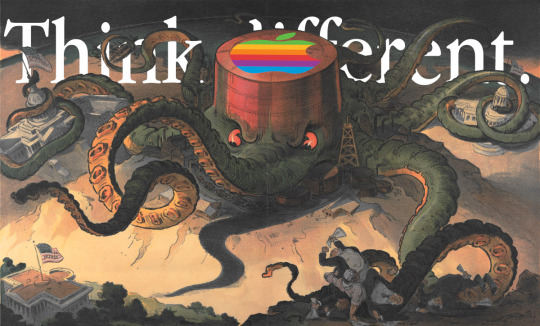
I'm on tour with my new, nationally bestselling novel The Bezzle! Catch me TONIGHT (Mar 22) in TORONTO, then SUNDAY (Mar 24) with LAURA POITRAS in NYC, then Anaheim, and beyond!

The foundational tenet of "the Cult of Mac" is that buying products from a $3t company makes you a member of an oppressed ethnic minority and therefore every criticism of that corporation is an ethnic slur:
https://pluralistic.net/2024/01/12/youre-holding-it-wrong/#if-dishwashers-were-iphones
Call it "Apple exceptionalism" – the idea that Apple, alone among the Big Tech firms, is virtuous, and therefore its conduct should be interpreted through that lens of virtue. The wellspring of this virtue is conveniently nebulous, which allows for endless goal-post shifting by members of the Cult of Mac when Apple's sins are made manifest.
Take the claim that Apple is "privacy respecting," which is attributed to Apple's business model of financing its services though cash transactions, rather than by selling it customers to advertisers. This is the (widely misunderstood) crux of the "surveillance capitalism" hypothesis: that capitalism is just fine, but once surveillance is in the mix, capitalism fails.
Apple, then, is said to be a virtuous company because its behavior is disciplined by market forces, unlike its spying rivals, whose ability to "hack our dopamine loops" immobilizes the market's invisible hand with "behavior-shaping" shackles:
http://pluralistic.net/HowToDestroySurveillanceCapitalism
Apple makes a big deal out of its privacy-respecting ethos, and not without some justification. After all, Apple went to the mattresses to fight the FBI when they tried to force Apple to introduced defects into its encryption systems:
https://www.eff.org/deeplinks/2018/04/fbi-could-have-gotten-san-bernardino-shooters-iphone-leadership-didnt-say
And Apple gave Ios users the power to opt out of Facebook spying with a single click; 96% of its customers took them up on this offer, costing Facebook $10b (one fifth of the pricetag of the metaverse boondoggle!) in a single year (you love to see it):
https://arstechnica.com/gadgets/2021/02/facebook-makes-the-case-for-activity-tracking-to-ios-14-users-in-new-pop-ups/
Bruce Schneier has a name for this practice: "feudal security." That's when you cede control over your device to a Big Tech warlord whose "walled garden" becomes a fortress that defends you against external threats:
https://pluralistic.net/2021/06/08/leona-helmsley-was-a-pioneer/#manorialism
The keyword here is external threats. When Apple itself threatens your privacy, the fortress becomes a prison. The fact that you can't install unapproved apps on your Ios device means that when Apple decides to harm you, you have nowhere to turn. The first Apple customers to discover this were in China. When the Chinese government ordered Apple to remove all working privacy tools from its App Store, the company obliged, rather than risk losing access to its ultra-cheap manufacturing base (Tim Cook's signal accomplishment, the one that vaulted him into the CEO's seat, was figuring out how to offshore Apple manufacturing to China) and hundreds of millions of middle-class consumers:
https://www.reuters.com/article/us-china-apple-vpn/apple-says-it-is-removing-vpn-services-from-china-app-store-idUSKBN1AE0BQ
Killing VPNs and other privacy tools was just for openers. After Apple caved to Beijing, the demands kept coming. Next, Apple willingly backdoored all its Chinese cloud services, so that the Chinese state could plunder its customers' data at will:
https://www.nytimes.com/2021/05/17/technology/apple-china-censorship-data.html
This was the completely foreseeable consequence of Apple's "curated computing" model: once the company arrogated to itself the power to decide which software you could run on your own computer, it was inevitable that powerful actors – like the Chinese Communist Party – would lean on Apple to exercise that power in service to its goals.
Unsurprisingly, the Chinese state's appetite for deputizing Apple to help with its spying and oppression was not sated by backdooring iCloud and kicking VPNs out of the App Store. As recently as 2022, Apple continued to neuter its tools at the behest of the Chinese state, breaking Airdrop to make it useless for organizing protests in China:
https://pluralistic.net/2022/11/11/foreseeable-consequences/#airdropped
But the threat of Apple turning on its customers isn't limited to China. While the company has been unwilling to spy on its users on behalf of the US government, it's proven more than willing to compromise its worldwide users' privacy to pad its own profits. Remember when Apple let its users opt out of Facebook surveillance with one click? At the very same time, Apple was spinning up its own commercial surveillance program, spying on Ios customers, gathering the very same data as Facebook, and for the very same purpose: to target ads. When it came to its own surveillance, Apple completely ignored its customers' explicit refusal to consent to spying, spied on them anyway, and lied about it:
https://pluralistic.net/2022/11/14/luxury-surveillance/#liar-liar
Here's the thing: even if you believe that Apple has a "corporate personality" that makes it want to do the right thing, that desire to be virtuous is dependent on the constraints Apple faces. The fact that Apple has complete legal and technical control over the hardware it sells – the power to decide who can make software that runs on that hardware, the power to decide who can fix that hardware, the power to decide who can sell parts for that hardware – represents an irresistible temptation to enshittify Apple products.
"Constraints" are the crux of the enshittification hypothesis. The contagion that spread enshittification to every corner of our technological world isn't a newfound sadism or indifference among tech bosses. Those bosses are the same people they've always been – the difference is that today, they are unconstrained.
Having bought, merged or formed a cartel with all their rivals, they don't fear competition (Apple buys 90+ companies per year, and Google pays it an annual $26.3b bribe for default search on its operating systems and programs).
Having captured their regulators, they don't fear fines or other penalties for cheating their customers, workers or suppliers (Apple led the coalition that defeated dozens of Right to Repair bills, year after year, in the late 2010s).
Having wrapped themselves in IP law, they don't fear rivals who make alternative clients, mods, privacy tools or other "adversarial interoperability" tools that disenshittify their products (Apple uses the DMCA, trademark, and other exotic rules to block third-party software, repair, and clients).
True virtue rests not merely in resisting temptation to be wicked, but in recognizing your own weakness and avoiding temptation. As I wrote when Apple embarked on its "curated computing" path, the company would eventually – inevitably – use its power to veto its customers' choices to harm those customers:
https://memex.craphound.com/2010/04/01/why-i-wont-buy-an-ipad-and-think-you-shouldnt-either/
Which is where we're at today. Apple – uniquely among electronics companies – shreds every device that is traded in by its customers, to block third parties from harvesting working components and using them for independent repair:
https://www.vice.com/en/article/yp73jw/apple-recycling-iphones-macbooks
Apple engraves microscopic Apple logos on those parts and uses these as the basis for trademark complaints to US customs, to block the re-importation of parts that escape its shredders:
https://repair.eu/news/apple-uses-trademark-law-to-strengthen-its-monopoly-on-repair/
Apple entered into an illegal price-fixing conspiracy with Amazon to prevent used and refurbished devices from being sold in the "world's biggest marketplace":
https://pluralistic.net/2022/11/10/you-had-one-job/#thats-just-the-as
Why is Apple so opposed to independent repair? Well, they say it's to keep users safe from unscrupulous or incompetent repair technicians (feudal security). But when Tim Cook speaks to his investors, he tells a different story, warning them that the company's profits are threatened by customers who choose to repair (rather than replace) their slippery, fragile glass $1,000 pocket computers (the fortress becomes a prison):
https://www.apple.com/newsroom/2019/01/letter-from-tim-cook-to-apple-investors/
All this adds up to a growing mountain of immortal e-waste, festooned with miniature Apple logos, that our descendants will be dealing with for the next 1,000 years. In the face of this unspeakable crime, Apple engaged in a string of dishonest maneuvers, claiming that it would support independent repair. In 2022, Apple announced a home repair program that turned out to be a laughably absurd con:
https://pluralistic.net/2022/05/22/apples-cement-overshoes/
Then in 2023, Apple announced a fresh "pro-repair" initiative that, once again, actually blocked repair:
https://pluralistic.net/2023/09/22/vin-locking/#thought-differently
Let's pause here a moment and remember that Apple once stood for independent repair, and celebrated the independent repair technicians that kept its customers' beloved Macs running:
https://pluralistic.net/2021/10/29/norwegian-potato-flour-enchiladas/#r2r
Whatever virtue lurks in Apple's corporate personhood, it is no match for the temptation that comes from running a locked-down platform designed to capture IP rights so that it can prevent normal competitive activities, like fixing phones, processing payments, or offering apps.
When Apple rolled out the App Store, Steve Jobs promised that it would save journalism and other forms of "content creation" by finally giving users a way to pay rightsholders. A decade later, that promise has been shattered by the app tax – a 30% rake on every in-app transaction that can't be avoided because Apple will kick your app out of the App Store if you even mention that your customers can pay you via the web in order to avoid giving a third of their content dollars to a hardware manufacturer that contributed nothing to the production of that material:
https://www.eff.org/deeplinks/2023/06/save-news-we-must-open-app-stores
Among the apps that Apple also refuses to allow on Ios is third-party browsers. Every Iphone browser is just a reskinned version of Apple's Safari, running on the same antiquated, insecure Webkit browser engine. The fact that Webkit is incomplete and outdated is a feature, not a bug, because it lets Apple block web apps – apps delivered via browsers, rather than app stores:
https://pluralistic.net/2022/12/13/kitbashed/#app-store-tax
Last month, the EU took aim at Apple's veto over its users' and software vendors' ability to transact with one another. The newly in-effect Digital Markets Act requires Apple to open up both third-party payment processing and third-party app stores. Apple's response to this is the very definition of malicious compliance, a snake's nest of junk-fees, onerous terms of service, and petty punitive measures that all add up to a great, big "Go fuck yourself":
https://pluralistic.net/2024/02/06/spoil-the-bunch/#dma
But Apple's bullying, privacy invasion, price-gouging and environmental crimes are global, and the EU isn't the only government seeking to end them. They're in the firing line in Japan:
https://asia.nikkei.com/Business/Technology/Japan-to-crack-down-on-Apple-and-Google-app-store-monopolies
And in the UK:
https://www.gov.uk/government/news/cma-wins-appeal-in-apple-case
And now, famously, the US Department of Justice is coming for Apple, with a bold antitrust complaint that strikes at the heart of Apple exceptionalism, the idea that monopoly is safer for users than technological self-determination:
https://www.justice.gov/opa/media/1344546/dl?inline
There's passages in the complaint that read like I wrote them:
Apple wraps itself in a cloak of privacy, security, and consumer preferences to justify its anticompetitive conduct. Indeed, it spends billions on marketing and branding to promote the self-serving premise that only Apple can safeguard consumers’ privacy and security interests. Apple selectively compromises privacy and security interests when doing so is in Apple’s own financial interest—such as degrading the security of text messages, offering governments and certain companies the chance to access more private and secure versions of app stores, or accepting billions of dollars each year for choosing Google as its default search engine when more private options are available. In the end, Apple deploys privacy and security justifications as an elastic shield that can stretch or contract to serve Apple’s financial and business interests.
After all, Apple punishes its customers for communicating with Android users by forcing them to do so without any encryption. When Beeper Mini rolled out an Imessage-compatible Android app that fixed this, giving Iphone owners the privacy Apple says they deserve but denies to them, Apple destroyed Beeper Mini:
https://blog.beeper.com/p/beeper-moving-forward
Tim Cook is on record about this: if you want to securely communicate with an Android user, you must "buy them an Iphone":
https://www.theverge.com/2022/9/7/23342243/tim-cook-apple-rcs-imessage-android-iphone-compatibility
If your friend, family member or customer declines to change mobile operating systems, Tim Cook insists that you must communicate without any privacy or security.
Even where Apple tries for security, it sometimes fails ("security is a process, not a product" -B. Schneier). To be secure in a benevolent dictatorship, it must also be an infallible dictatorship. Apple's far from infallible: Eight generations of Iphones have unpatchable hardware defects:
https://checkm8.info/
And Apple's latest custom chips have secret-leaking, unpatchable vulnerabilities:
https://arstechnica.com/security/2024/03/hackers-can-extract-secret-encryption-keys-from-apples-mac-chips/
Apple's far from infallible – but they're also far from benevolent. Despite Apple's claims, its hardware, operating system and apps are riddled with deliberate privacy defects, introduce to protect Apple's shareholders at the expense of its customers:
https://proton.me/blog/iphone-privacy
Now, antitrust suits are notoriously hard to make, especially after 40 years of bad-precedent-setting, monopoly-friendly antitrust malpractice. Much of the time, these suits fail because they can't prove that tech bosses intentionally built their monopolies. However, tech is a written culture, one that leaves abundant, indelible records of corporate deliberations. What's more, tech bosses are notoriously prone to bragging about their nefarious intentions, committing them to writing:
https://pluralistic.net/2023/09/03/big-tech-cant-stop-telling-on-itself/
Apple is no exception – there's an abundance of written records that establish that Apple deliberately, illegally set out to create and maintain a monopoly:
https://www.wired.com/story/4-internal-apple-emails-helped-doj-build-antitrust-case/
Apple claims that its monopoly is beneficent, used to protect its users, making its products more "elegant" and safe. But when Apple's interests conflict with its customers' safety and privacy – and pocketbooks – Apple always puts itself first, just like every other corporation. In other words: Apple is unexceptional.
The Cult of Mac denies this. They say that no one wants to use a third-party app store, no one wants third-party payments, no one wants third-party repair. This is obviously wrong and trivially disproved: if no Apple customer wanted these things, Apple wouldn't have to go to enormous lengths to prevent them. The only phones that an independent Iphone repair shop fixes are Iphones: which means Iphone owners want independent repair.
The rejoinder from the Cult of Mac is that those Iphone owners shouldn't own Iphones: if they wanted to exercise property rights over their phones, they shouldn't have bought a phone from Apple. This is the "No True Scotsman" fallacy for distraction-rectangles, and moreover, it's impossible to square with Tim Cook's insistence that if you want private communications, you must buy an Iphone.
Apple is unexceptional. It's just another Big Tech monopolist. Rounded corners don't preserve virtue any better than square ones. Any company that is freed from constraints – of competition, regulation and interoperability – will always enshittify. Apple – being unexceptional – is no exception.

Name your price for 18 of my DRM-free ebooks and support the Electronic Frontier Foundation with the Humble Cory Doctorow Bundle.

If you'd like an essay-formatted version of this post to read or share, here's a link to it on pluralistic.net, my surveillance-free, ad-free, tracker-free blog:
https://pluralistic.net/2024/03/22/reality-distortion-field/#three-trillion-here-three-trillion-there-pretty-soon-youre-talking-real-money
#pluralistic#apple#antitrust#cult of mac#ios#mobile#app tax#infosec#feudal security#doj#jonathan kanter#doj v apple#big tech#trustbusting#monopolies#app stores#technofeudalism#technomaorialism#privacy#right to repair#corruption
239 notes
·
View notes
Text
AI’s energy use already represents as much as 20 percent of global data-center power demand, research published Thursday in the journal Joule shows. That demand from AI, the research states, could double by the end of this year, comprising nearly half of all total data-center electricity consumption worldwide, excluding the electricity used for bitcoin mining.
The new research is published in a commentary by Alex de Vries-Gao, the founder of Digiconomist, a research company that evaluates the environmental impact of technology. De Vries-Gao started Digiconomist in the late 2010s to explore the impact of bitcoin mining, another extremely energy-intensive activity, would have on the environment. Looking at AI, he says, has grown more urgent over the past few years because of the widespread adoption of ChatGPT and other large language models that use massive amounts of energy. According to his research, worldwide AI energy demand is now set to surpass demand from bitcoin mining by the end of this year.
“The money that bitcoin miners had to get to where they are today is peanuts compared to the money that Google and Microsoft and all these big tech companies are pouring in [to AI],” he says. “This is just escalating a lot faster, and it’s a much bigger threat.”
The development of AI is already having an impact on Big Tech’s climate goals. Tech giants have acknowledged in recent sustainability reports that AI is largely responsible for driving up their energy use. Google’s greenhouse gas emissions, for instance, have increased 48 percent since 2019, complicating the company’s goals of reaching net zero by 2030.
“As we further integrate AI into our products, reducing emissions may be challenging due to increasing energy demands from the greater intensity of AI compute,” Google’s 2024 sustainability report reads.
Last month, the International Energy Agency released a report finding that data centers made up 1.5 percent of global energy use in 2024—around 415 terrawatt-hours, a little less than the yearly energy demand of Saudi Arabia. This number is only set to get bigger: Data centers’ electricity consumption has grown four times faster than overall consumption in recent years, while the amount of investment in data centers has nearly doubled since 2022, driven largely by massive expansions to account for new AI capacity. Overall, the IEA predicted that data center electricity consumption will grow to more than 900 TWh by the end of the decade.
But there’s still a lot of unknowns about the share that AI, specifically, takes up in that current configuration of electricity use by data centers. Data centers power a variety of services—like hosting cloud services and providing online infrastructure—that aren’t necessarily linked to the energy-intensive activities of AI. Tech companies, meanwhile, largely keep the energy expenditure of their software and hardware private.
Some attempts to quantify AI’s energy consumption have started from the user side: calculating the amount of electricity that goes into a single ChatGPT search, for instance. De Vries-Gao decided to look, instead, at the supply chain, starting from the production side to get a more global picture.
The high computing demands of AI, De Vries-Gao says, creates a natural “bottleneck” in the current global supply chain around AI hardware, particularly around the Taiwan Semiconductor Manufacturing Company (TSMC), the undisputed leader in producing key hardware that can handle these needs. Companies like Nvidia outsource the production of their chips to TSMC, which also produces chips for other companies like Google and AMD. (Both TSMC and Nvidia declined to comment for this article.)
De Vries-Gao used analyst estimates, earnings call transcripts, and device details to put together an approximate estimate of TSMC’s production capacity. He then looked at publicly available electricity consumption profiles of AI hardware and estimates on utilization rates of that hardware—which can vary based on what it’s being used for—to arrive at a rough figure of just how much of global data-center demand is taken up by AI. De Vries-Gao calculates that without increased production, AI will consume up to 82 terrawatt-hours of electricity this year—roughly around the same as the annual electricity consumption of a country like Switzerland. If production capacity for AI hardware doubles this year, as analysts have projected it will, demand could increase at a similar rate, representing almost half of all data center demand by the end of the year.
Despite the amount of publicly available information used in the paper, a lot of what De Vries-Gao is doing is peering into a black box: We simply don’t know certain factors that affect AI’s energy consumption, like the utilization rates of every piece of AI hardware in the world or what machine learning activities they’re being used for, let alone how the industry might develop in the future.
Sasha Luccioni, an AI and energy researcher and the climate lead at open-source machine-learning platform Hugging Face, cautioned about leaning too hard on some of the conclusions of the new paper, given the amount of unknowns at play. Luccioni, who was not involved in this research, says that when it comes to truly calculating AI’s energy use, disclosure from tech giants is crucial.
“It’s because we don’t have the information that [researchers] have to do this,” she says. “That’s why the error bar is so huge.”
And tech companies do keep this information. In 2022, Google published a paper on machine learning and electricity use, noting that machine learning was “10%–15% of Google’s total energy use” from 2019 to 2021, and predicted that with best practices, “by 2030 total carbon emissions from training will reduce.” However, since that paper—which was released before Google Gemini’s debut in 2023—Google has not provided any more detailed information about how much electricity ML uses. (Google declined to comment for this story.)
“You really have to deep-dive into the semiconductor supply chain to be able to make any sensible statement about the energy demand of AI,” De Vries-Gao says. “If these big tech companies were just publishing the same information that Google was publishing three years ago, we would have a pretty good indicator” of AI’s energy use.
19 notes
·
View notes
Text
Tech Made Easy: Simple Tips and Tricks for Navigating the Digital Landscape
Introduction In today’s fast-paced digital world, navigating the ever-changing landscape of technology can be daunting. However, with the right tips and tricks, mastering tech can be made easy. Whether you’re a beginner looking to improve your digital skills or a seasoned tech enthusiast seeking to stay on top of the latest trends, this guide will provide you with valuable insights to help you…
#advancements in artificial intelligence#cybersecurity best practices#emerging tech innovations#future of blockchain technology#guide to cloud computing#how to choose tech solutions for businesses#how to use new tech gadgets#impact of technology on business#Latest technology trends 2024#reviews of the latest tech products#tech tips and tutorials.#technology for smart homes#technology in healthcare#top technology startups#trends in mobile technology
0 notes
Text
"Microsoft, Amazon and Google among major corporations identified as being part of a “joint criminal enterprise” in helping Israel carry out a genocide in Gaza. The companies have made unprecedented profits from the slaughter of more than 62,000 Palestinians since October 2023.
In a landmark report released on 30 June, UN special rapporteur for the occupied Palestinian territories Francesca Albanese exposes the corporate machinery both sustaining and profiting from Israel’s occupation and apartheid in Gaza and the West Bank – and now its ongoing genocide in Gaza.
The report – entitled “From economy of occupation to economy of genocide” – identifies 48 separate corporate actors in sectors including, arms, tech, construction, tourism, energy, finance, academia and agriculture. According to the report, they represent only the “tip of the iceberg” as the broader web of corporate complicity is far larger.
It outlines how tech giants Microsoft, Alphabet (parent company of Google) and Amazon grant Israel access to their cloud and AI technologies, enhancing the Israeli government’s ability to process data, make decisions and conduct surveillance and analysis.
Israel’s apartheid and military systems require ever-growing cloud storage and computing capacity. To meet these needs, the Israeli government and military’s cloud computing project – known as Project Nimbus – brought Google and Amazon onboard with a $1.2bn contract in 2021.

When the Israeli internal military cloud overloaded in October 2023, Microsoft, Google and Amazon stepped in to provide crucial cloud and AI tech. IDF computer chief Col. Racheli Dembinsky recently described cloud tech as part of “a collection of systems with which the IDF fights to the end”, citing these companies in her onscreen presentation. Dembinsky said: “You have to understand that it’s a platform that’s a weapon.”
What’s more, Microsoft, Amazon and Google have established research and development (R&D) hubs and local data centres in Israel, while they enjoy what the report describes as “unprecedented government-granted access to data and a captive population”. According to Albanese’s report, this has helped unleash “the first AI-driven and livestreamed genocide, while providing the data sovereignty to shield impunity”.
Microsoft reported $70bn in sales and an 18% increase in profits in the first quarter of 2025, boosted by its cloud computing and artificial intelligence business. In the fourth quarter of 2024, Google Cloud revenues increased 30% to $12bn led by growth across core Google Cloud Platform products, AI Infrastructure, and generative AI solutions, while Amazon Web Services segment sales increased 19% to over $28bn.
The report states: “[Israel’s] forever-occupation has become the ideal testing ground for arms manufacturers and big tech – providing significant supply and demand, little oversight, and zero accountability – while investors and private and public institutions profit freely.” ...
this is the first half of the article - read the whole thing here: https://novaramedia.com/2025/07/02/tech-giants-and-british-bank-named-in-francesca-albanese-report-on-gaza-genocide/
Also, the advanced edited version of the UN report can be read and downloaded here:
https://www.ohchr.org/sites/default/files/documents/hrbodies/hrcouncil/sessions-regular/session59/advance-version/a-hrc-59-23-aev.pdf
7 notes
·
View notes
Text
By Madge Waggy MadgeWaggy.blogspot.com
December 30, 2024
According to Steven Overly From: www.politico.com The freakout moment that set journalist Byron Tau on a five-year quest to expose the sprawling U.S. data surveillance state occurred over a “wine-soaked dinner” back in 2018 with a source he cannot name.
The tipster told Tau the government was buying up reams of consumer data — information scraped from cellphones, social media profiles, internet ad exchanges and other open sources — and deploying it for often-clandestine purposes like law enforcement and national security in the U.S. and abroad. The places you go, the websites you visit, the opinions you post — all collected and legally sold to federal agencies.
I’m going to alert you to what many are considering to be on of the worst doomsday scenarios for free American patriots. One that apparently not many are prepping for, or even seem to care about.
By now everybody knows that the government ‘alphabet agencies’ including mainly the NSA have been methodically collecting data on us. Everything we do, say, buy and search on the internet will be on permanent data base file by next year. All phone calls now are computer monitored, automatically recorded and stored with certain flag/trigger words (in all languages).
As technology improves, every single phone call will be entirely recorded at meta-data bases in government computer cloud storage, when ‘They’ finish the huge NSA super spy center in Utah. Which means they will be available anytime authorities want to look them up and personally listen for any information reference to any future investigation. Super computer algorithms will pin point search extrapolations of ANY relationship to the target point.
You can rest uneasily, but assured, that in the very near future when a cop stops you and scans your driver license into his computer, he will know anything even remotely ’suspicious’ or ’questionable’ about ALL the recent activities and behavior in your life he chooses to focus upon!
This is the ‘privacy apocalypse’ coming upon us. And you need to know these five devices that you can run to protect your privacy, but you can’t hide from.
When Security Overlaps Freedom
11 notes
·
View notes
Text
2024 team sponsors recap!
this is completely irrelevant to F1 but i study and do these stuffs for a living sooo 😩😩 2023 sponsors are based on the sponsors that are there at the beginning of the season (new sponsors that join in the middle of the season will be classified as 2024's)
Mercedes AMG Petronas F1 Team:
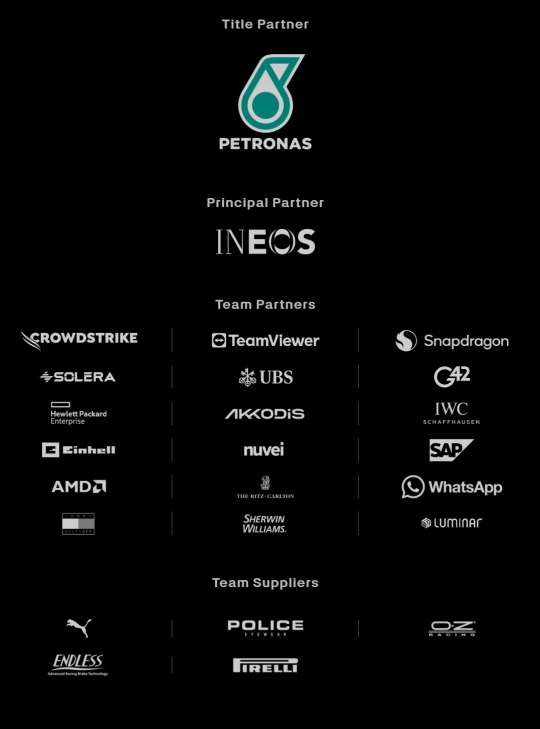
New sponsors: Whatsapp, Luminar (American tech company), SAP (German software company), nuvei (Canadian credit card services), Sherwin Williams (American painting company) 2024 data last update: 2024/02/14
Old sponsors that left: Monster Energy, Pure Storage (American technology company), fastly (American cloud computing services), Axalta (American painting company), Eight sleep (American mattresses company) 2023 data last update: 2023/01/07
Oracle Red Bull Racing F1 Team:
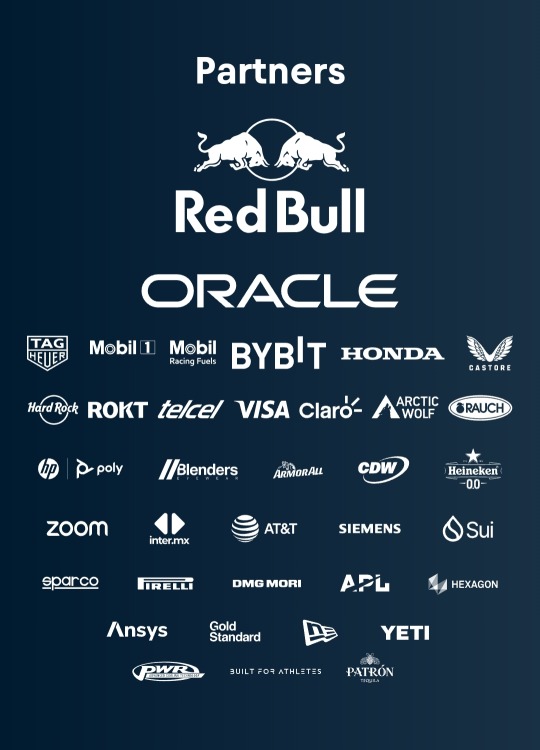
New sponsors: Yeti (American cooler manufacturer, joined later in 2023), APL (American footwear/athletic apparel manufacturer, joined later in 2023), CDW (American IT company, joined later in 2023), Sui (American tech app by Mysten Labs, joined later in 2023), Patron Tequila (Mexican alcoholic beverages company, joined later in 2023) 2024 data last update: 2024/02/15
Old sponsors that left: CashApp, Walmart, Therabody (American wellness technology company), Ocean Bottle (Norwegian reusable bottle manufacturer), PokerStars (Costa Rican gambling site), Alpha Tauri (? no info if they're official partners or not but Austrian clothing company made by Red Bull), BMC (Switzerland bicycle/cycling manufacturer), Esso (American fuel company, subsidiary of ExxonMobil), Hewlett Packard Enterprise (American technology company) 2023 data last update: 2023/03/07
More: Esso is a subsidiary of Mobil so there's possibility they merged or something
Scuderia Ferrari:
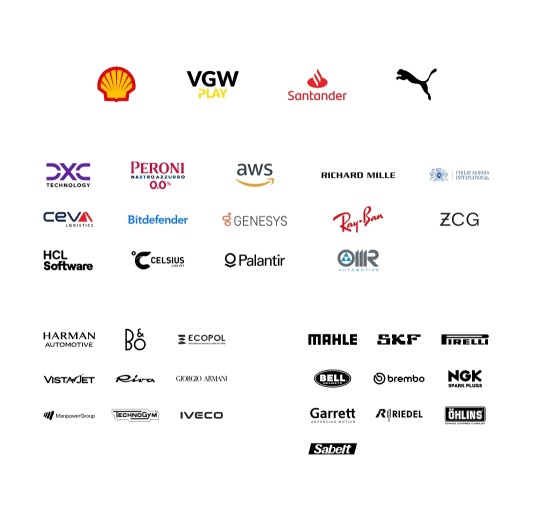
New sponsors: VGW Play (Australian tech game company, joined later in 2023), DXC Technology (American IT company, joined later in 2023), Peroni (Italian brewing company), Z Capital Group/ZCG (American private asset management/merchant bank company), Celsius (Swedish energy drink manufacturer) 2024 data last update: 2024/02/15
Old sponsors that left: Mission Winnow (American content lab by Phillip Morris International aka Marlboro), Estrella Garcia (Spanish alcoholic beverages manufacturer), Frecciarossa (Italian high speed train company) 2023 data last update: 2023/02/16
More: Mission Winnow is a part of Phillip Morris International. They are no longer listed as team sponsor but PMI is listed instead.
(starting here, 2023 data last update is 2023/02/23 and 2024 data last update is 2024/02/15)
McLaren F1 Team: (Only McLaren RACING's data is available idk if some of these are XE/FE team partners but anw..)
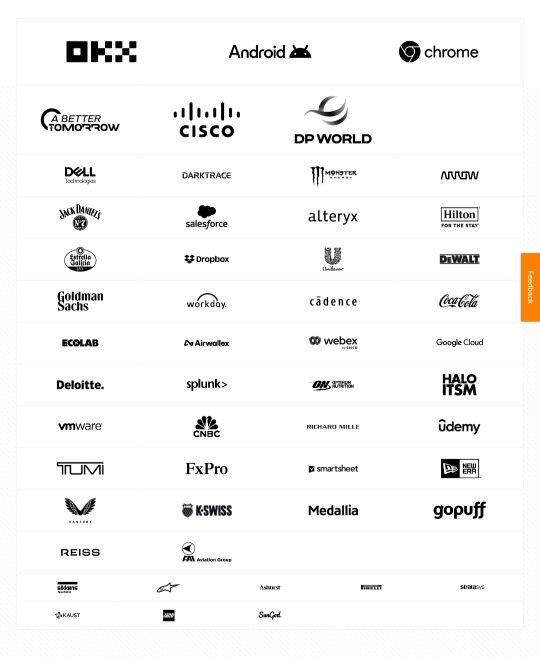
New sponsors: Monster Energy, Salesforce (American cloud based software company, joined later in 2023), Estrella Garcia (Spanish alcoholic beverages manufacturer), Dropbox (American file hosting company), Workday (American system software company, joined later in 2023), Ecolab (American water purification/hygiene company), Airwallex (Australian financial tech company), Optimum Nutrition (American nutritional supplement manufacturer), Halo ITSM (American software company, joined later in 2023), Udemy (American educational tech company, joined later in 2023), New Era (American cap manufacturer, joined in 2023), K-Swiss (American shoes manufacturer, joined later in 2023), Alpinestars (Italian motorsports safety equipment manufacturer)
Old sponsors that left: DP World (Emirati logistics company), EasyPost (American shipping API company), Immersive Labs (UK cybersecurity training company?), Logitech, Mind (UK mental health charity), PartyCasino (UK? online casino site), PartyPoker (American? gambling site), Sparco (Italian auto part & accessory manufacturer), Tezos (Switzerland crypto company)
Aston Martin Aramco F1 Team:
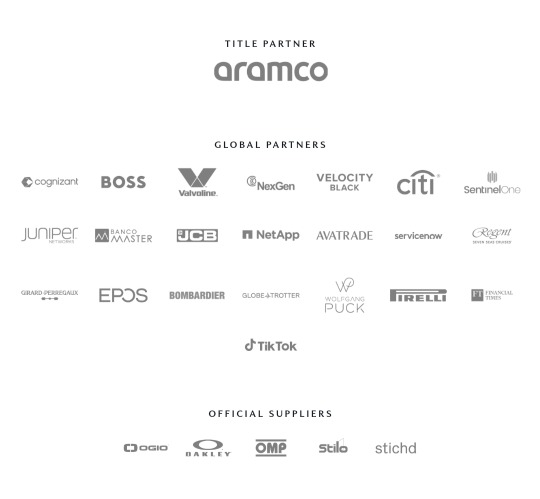
New sponsors: Valvoline (American retail automotives service company, joined later in 2023), NexGen (Canadian sustainable? fuel company), Banco Master (Brazilian digital banking platform, joined later in 2023), ServiceNow (American software company, joined later in 2023), Regent Seven Seas Cruise, Wolfgang Puck (Austrian-American chef and restaurant owner, joined later in 2023), Financial Times (British business newspaper), OMP (Italian racing safety equipment manufacturer), stichd (Netherlands fashion & apparel manufacturer)
Old sponsors that left: Alpinestars (Italian motorsports safety equipment manufacturer), crypto.com (Singaporean cryptocurrency company), ebb3 (UK? software company), Pelmark (UK fashion and apparel manufacturer), Peroni (Italian brewing company), Porto Seguro (Brazilian insurance company), Socios (Malta's blockchain-based platform), XP (Brazilian investment company)
Stake F1 Team (prev. Alfa Romeo):
???? Can't found their website (might be geoblocked in my country???)
BWT Alpine F1 Team:
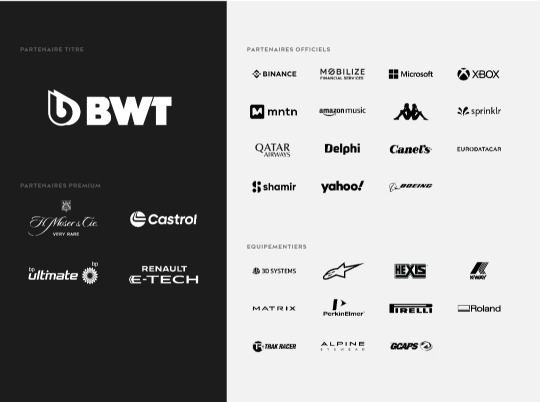
New sponsors: MNTN (American software company), H. Moser & Cie (Switzerland watch manufacturer), Amazon Music
Old sponsors that left: Bell & Ross (French watch company), Ecowatt (??? afaik French less-energy smthn smthn company), Elysium (French? American? Software company), KX (UK software company), Plug (American electrical equipment manufacturing company)
Visa CashApp RB F1 Team (prev. Scuderia Alpha Tauri):
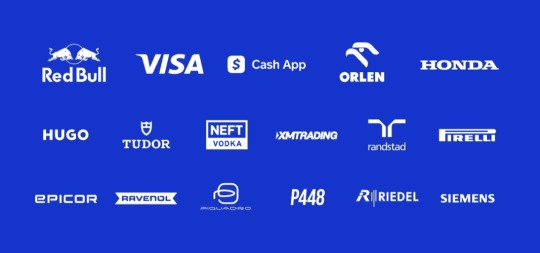
New Sponsors: Visa, CashApp, Hugo Boss, Tudor, Neft Vodka (Austrian alcoholic beverages company), Piquadro (Italian luxury bag manufacturer)
Old sponsors that left: Buzz (?), Carl Friedrik (UK travel goods manufacturer), Flex Box (Hongkong? shipping containers manufacturer), GMG (Emirati global wellbeing company), RapidAPI (American API company)
Haas F1 Team:

New sponsors: New Era (American cap manufacturer, joined later in 2023)
Old sponsors that left: Hantec Markets (Hongkong capital markets company), OpenSea (American NFT/Crypto company)
Williams Racing:

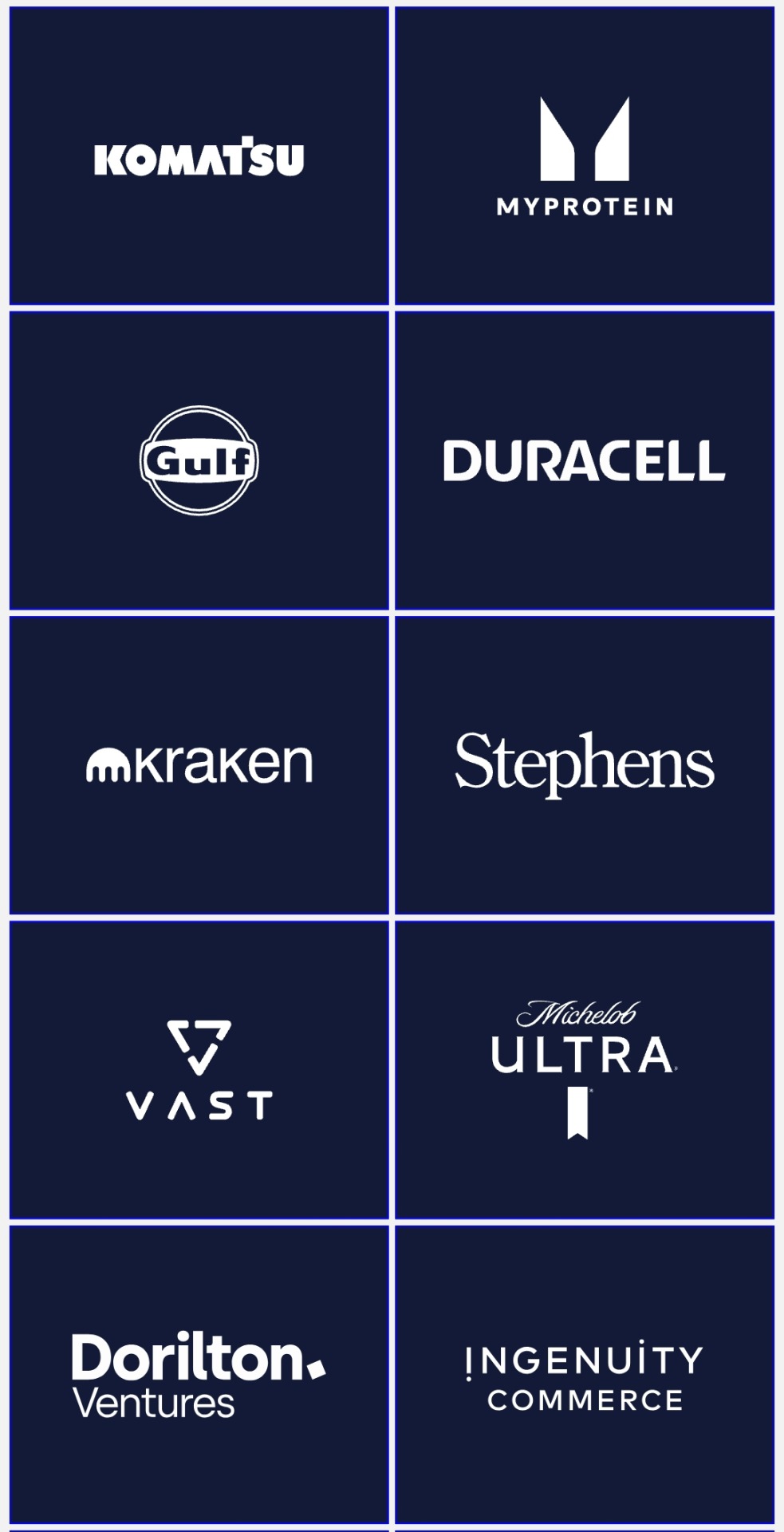
New sponsors: Komatsu, MyProtein (British bodybuilding supplement), Kraken (American crypto company, joined later in 2023), VAST Data (American tech company), Ingenuity Commerce (UK e-commerce platform), Puma (joined later in 2023)
Old sponsors that left: Acronis (Swiss software company), Bremont (British watch manufacturer), Dtex Systems (American? cybersecurity company), Financial Times (British business newspaper), Jumeirah Hotels & Resorts, KX (UK software company), OMP (Italian racing safety equipment manufacturer), PPG (American painting manufacturer), Umbro (English sports equipment manufacturer), Zeiss (German opticals/optometrics manufacturing company)
#mercedes amg petronas#red bull racing#scuderia ferrari#visa cash app rb#haas f1 team#mclaren f1#aston martin#alpine f1#williams racing#stake f1 team#f1#ari's rant#sponsor talks
42 notes
·
View notes
Text
The Latest Breakthroughs in Technology for 2024
Introduction
Welcome to TechtoIO, your go-to source for the latest in tech news and trends. As we dive into 2024, the tech landscape continues to evolve at a rapid pace. From artificial intelligence advancements to breakthroughs in quantum computing, this year promises to be a landmark in technological innovation. In this comprehensive guide, we’ll explore the most exciting developments in technology for 2024, offering insights into how these advancements will impact our lives and industries. Read to continue
#Innovation Insights#Tags2024 tech innovations#5G technology 2024#AI in education 2024#AI in healthcare 2024#artificial intelligence advancements 2024#autonomous vehicles 2024#blockchain technology advancements 2024#commercial space flights 2024#CRISPR gene editing 2024#deep space missions 2024#edge computing 2024#electric vehicles 2024#industrial automation 2024#latest breakthroughs in technology 2024#quantum computing breakthroughs#renewable energy innovations 2024#solar power advancements#space exploration technology 2024#synthetic biology breakthroughs#wind energy technology 2024#Technology#Science#business tech#Adobe cloud#Trends#Nvidia Drive#Analysis#Tech news#Science updates
1 note
·
View note